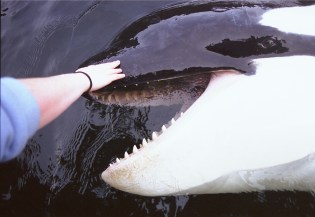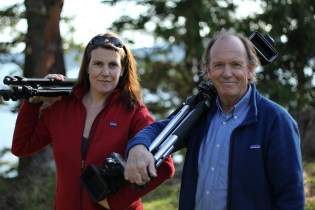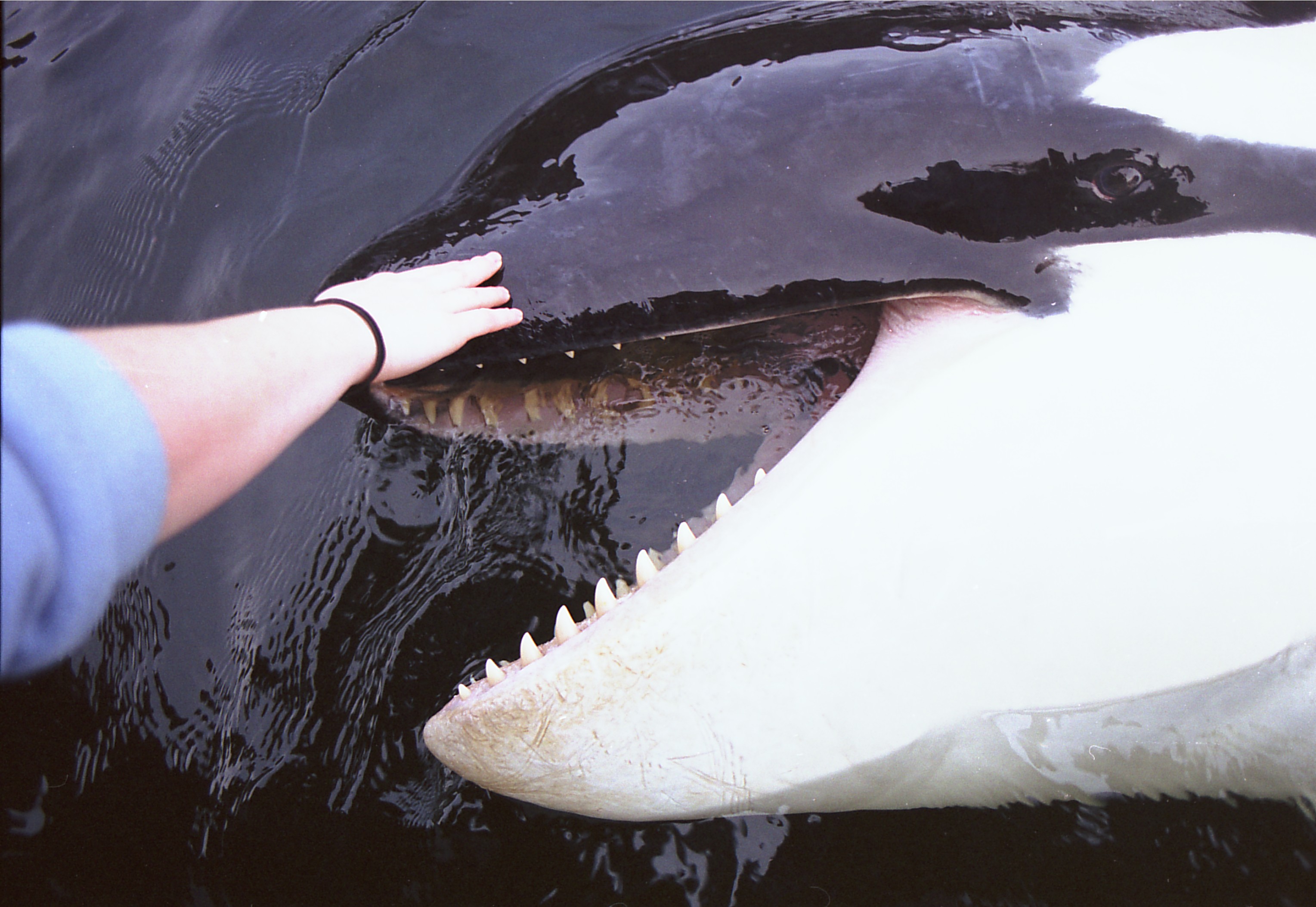
Luna craved human contact. (Photo by Mountainside Films.)
When husband-and-wife journalists Michael Parfit and Suzanne Chisholm first heard about a lone orca whale hanging out in Nootka Sound, a rugged inlet along Vancouver Island off British Columbia’s west coast, they thought attempts to reunite the creature with its pod would make “a very sweet, small story.” But as they spent the summer of 2004 learning how this young male (nicknamed Luna) showed up suddenly and mysteriously after getting separated from his pod three years before, they found themselves sucked into the action. By the time Parfit’s Smithsonian article about Luna came out in November of that year, attempts to move the whale out of Nootka Sound had failed, his future was uncertain, and Parfit and Chisholm knew they couldn’t let go of Luna or his story yet.
Last September, the couple released The Whale, a feature-length documentary narrated by Ryan Reynolds (a B.C. native) and produced by Scarlett Johansson. The buzzworthy film chronicles the controversy surrounding Luna, who captivated locals with his desire for social interaction and attention, but concerned scientists who worried that such contact would ultimately prove dangerous for both human and whale. To the Mowachaht-Muchalaht people living near Nootka Sound, Luna had special importance: They saw him as the incarnation of a past tribal leader, and made bold moves to block attempts to capture the whale and remove him from the area.
Beyond the narrative drama of The Whale’s plot, what so affected those involved in the story (and now touches viewers) is the evidence of an incredible interspecies bond that developed between Luna and those who knew him. It’s an experience that defies what we think we know about the potential of human-animal communication. We caught up with Parfit to talk more about The Whale and the fascinating issues it brings up.
Q. What made you realize that Luna’s story was bigger than you anticipated? Why did you decide to go beyond a magazine article and make a full-length documentary about it?
A. It was a lot more than we thought it was really because of the lead character. Luna was such an extraordinary being, and so many things happened that we didn’t expect. We moved there expecting not to have any real contact with Luna. We went zooming across this bay where we thought he was, and all of a sudden he jumped behind us — we were going 15 knots — and the next thing that happened was he just exploded [out of the water] right beside our boat. We rushed over to the shore because we weren’t supposed to be interacting with him, and there he was rolling on his side in shallow water, looking at us. There was such consciousness there, such deliberate intent to connect; it was just this unforgettable moment. We had suddenly experienced what everyone else on Nootka Sound had been experiencing. We began to understand in an emotional, visceral way the power this experience had in people’s lives. Getting Ryan Reynolds involved as a way to reach out to more people is all part of this effort to tell a story that we think has a lot of resonance in terms of our relationship with the natural world.

Suzanne Chisholm and Mike Parfit. (Photo by Mountainside Films.)
Q. At a certain point in the film, the two of you take an active role in the debate over what to do about Luna. What made you decide it was time to step out of your roles as journalists and get directly involved?
A. We really became troubled, ourselves, that the decisions being made at a distance were very dangerous for Luna. [They were] based upon the idea that the problems would all go away if people could be persuaded to avoid playing with Luna. The evidence on the scene was that Luna was so determined that this interaction would continue. We had a fairly naïve idea that we would start a conversation among people who cared about Luna and get to a different place of helping him. It didn’t work. Things happened that were unnecessarily tragic. A lot of people feel very strongly about what our relationship with wild animals should be.
Q. The film discusses the topic of anthropomorphism — ascribing human traits and emotions to animals — and how it’s often frowned upon by biologists. How did Luna’s interaction with the humans living on Nootka Sound challenge traditional ideas about the minds of animals?
A. There was a strong thread running through biology that [if] animals look like they’re having emotions, [it’s because] you’re just indulging your desire to see an emotion in the animal. That was a pretty widely accepted attitude in biology for decades. It’s been changing for the past few years.
The negative part of anthropomorphism is when you completely write thoughts into an animal’s head, saying, “My dog is coming over and sitting down with me because he knows I’m sad.” What the dog is actually feeling is beyond us, but the idea that they don’t experience life at any level that we do emotionally, that has really changed. What the experience with Luna gave us is a sense of the fellowship of the wild that we’re part of; that sense that we’re in this together with these beings who are out there longing and suffering and expecting joy and going through something that is not so different from us, and yet is, in amazingly mysterious ways that we can only approach in an empathetic way, but not a way we can actually pin down.
We’re looking at these [animals’] lives and we describe them as being inferior to us, when in fact their lives are so rich and complex and their awareness of living is so present. In a very small sense, what Luna was saying is [people] are not paying attention to what he was asking for. We need to learn how to respect these other members of the fellowship and try to learn what they need. People say [our] film promotes direct interaction with whales. The answer is no — the film is telling a single story about a unique event. There’s a great deal we have to learn about how to respect animals’ lives, but when one comes out of the wild and connects with us, we have things to learn there, too.
Q. How have audiences reacted to the film so far?
A. People describe the film as life-affirming. They see it as sad, but not dark. Children come back and want to see it again. When we watch the film, there are times when we still shed tears. So for people to come up to us and describe it as being uplifting is both startling and gratifying. What people respond to in films is not necessarily achievements or victory, but persistence and relationships. The movie is all about the importance of relationships. Even when you share grief with other people on the screen and you feel that your grief is of value and describing a loss that was important, there’s something about that sharing and sense of community and connectedness that leaves us feeling good.
To me, the film is saying there’s this connection that we feel to that natural world that is not imaginary. Every once in awhile you have this little glimpse of all this connectedness going on, and when you see that little glimpse, even when it’s tenuous, it’s so powerful that it changes your life.




